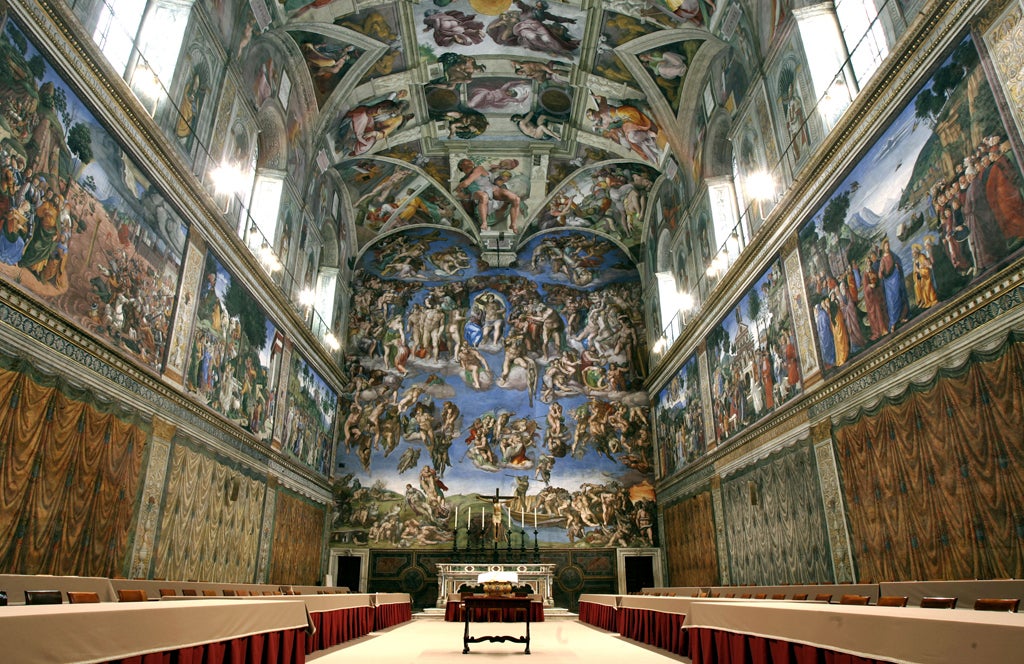Still fresco at 500: Today marks five centuries of the Sistine Chapel's ceiling frescoes - but Vatican warns it might limit visitors

Michelangelo's Sistine Chapel ceiling frescoes turned 500 on today with the Vatican warning it may eventually limit visitors to protect one of the wonders of Western civilisation.
On 31 October 1512, only 20 years after the discovery of America, Pope Julius II said an evening vespers service to inaugurate the room where Michelangelo toiled for four years, much of it on his back, to finish his ceiling frescoes.
The frescoes immediately became the talk of the town and have since become the talk of the world.
The problem is that it sometimes feels that they have become the walk of the world. The Sistine Chapel is arguably the most visited room in the world.
With mass tourism growing, every year some five million people, as many as 20,000 a day in summer, enter the chapel, crane their necks upwards. Most are left awestruck.
The ceiling of the chapel, where cardinals meet in secret conclaves to elect new the pope, includes one of the most famous scenes in the history of art - the arm of a gentle bearded God reaching out to give life to Adam in the creation panel.
Earlier this month, Italian literary critic Pietro Citati sparked a storm by writing an open letter in a major Italian newspaper denouncing the behaviour of crowds visiting what is technically a sacred place.
Tourists, he said, "resemble drunken herds" as they unwittingly risked damaging the frescoes with their breath, their perspiration, the dust on their shoes and their body heat.
The atmosphere, Citati wrote, was anything but contemplative as the tourists ignored the Vatican's requests for silence, composure and a ban on taking photographs.
SWEAT, DUST AND CARBON DIOXIDE
Citati became the latest critic to demand that the Vatican severely limit the number of visitors to the Sistine, a must-see for visitors to the eternal city.
Antonio Paolucci, the director of the Vatican Museums, said he did not foresee limiting the number of visitors "in the short and medium term" but said the museums might not have any choice after that.
"Pressure caused by humans such as dust introduced, the humidity of bodies, carbon dioxide produced by perspiration can cause unease for the visitors, and in the long run, possible damage to the paintings," Paolucci said in an article in the Vatican newspaper to mark the 500th birthday of the ceiling frescoes.
"We might limit the access, putting a cap on the number (of visitors). We will do this if tourism grows beyond the limits of reasonable tolerance and if we are not able to respond adequately to the problem," he said.
Under the current system, visitors to the Vatican museums can either book times to enter or wait in long queues outside, but there is no cap on the total daily number.
In 1994, at the end of a 14-year restoration project, technicians installed an elaborate system of dehumidifiers, air conditioning, filters and micro-climate controls in the chapel.
But the number of visitors has grown in the past 18 years, putting the system under stress.
Paolucci said Carrier air conditioning, a unit of United Technologies, was studying a "new, high-tech, radically innovative" project to protect the frescoes from atmospheric damage. The new equipment should be ready in a year, he said.
The director of the museums said the Sistine, where Michelangelo returned between 1535 and 1541 to paint the monumental Last Judgement panel behind the main altar, is for many a "fatal attraction, an object of desire".
He said a way would have to be found to allow as many people as possible to satisfy their artistic yearning while at the same time defending the precious frescoes from damage.
SISTINE CHAPEL FACTS
- The Sistine Chapel was commissioned by Pope Sixtus IV, from whom it derives its name, in 1475. It was designed to be - and still is - where Catholic cardinals hold conclaves to elect a new pope and was first used for that purpose after the death of Sixtus in 1484.
- Michelangelo painted most of the chapel in two periods between 1508 and 1541. It is now part of the Vatican Museums and is open to the public when it is not being used by the pope.
- Michelangelo painted the ceiling between 1508 and 1512 and the Last Judgement panel between 1535 and 1541. It is one of the world's most famous treasures of Renaissance art. Wednesday is the 500th anniversary of the inauguration of the ceiling frescoes in 1512.
- Michelangelo was accused of immorality and obscenity for depicting naked figures in a church. After his death, Church officials ordered another artist to paint loincloths over the offending genitalia.
- The side walls were decorated by other artists, including Pietro Perugino, Sandro Botticelli and Domenico Ghirlandaio.
- In 1994 Pope John Paul opened the restored Sistine Chapel after frescoes were returned to their original splendour by a 14-year cleaning project.
- At the time, some critics said the frescoes were damaged. But most agreed that the project had brought life back to the colours, which had been dimmed by centuries of candle and incense smoke, grime, and previous botched restorations.
Reuters
Join our commenting forum
Join thought-provoking conversations, follow other Independent readers and see their replies
Comments